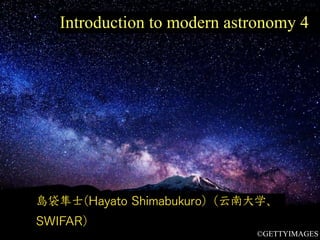
lecture4
- 1. Introduction to modern astronomy 4 島袋隼⼠(Hayato Shimabukuro)(云南⼤学、 SWIFAR) ©GETTYIMAGES
- 2. Contents • 2. The history of astronomy : The birth of modern astronomy • Summary
- 3. 2.The history of the astronomy ~ The birth of modern astronomy~
- 4. In previous lecture, I introduced the transition from Geocentric(地⼼宇宙) model to Heliocentric (⽇⼼宇宙) model. Copernican revolution However, in the era of Copernicus, Heliocentric model was not accepted. How did human open modern astronomy?? Isaac Newton (1642-1727) Galileo Galilei (1564-1642) Johannes Kepler (1571-1630) Tycho Brahe (1546-1601)
- 5. Galileo Galilei (1564-1642) •Galileo Galilei invented telescope in 1609. Galileo’s telescope •He discovered that the moon had mountains, valleys, and craters (Galileo’s sketch) •Galileo’s observation supports the idea of Copernicus. 太阳中⼼模型 地⼼模型
- 6. Galileo Galilei (1564-1642) •Galileo Galilei invented telescope in 1609. Galileo’s telescope •He discovered that the moon had mountains, valleys, and craters (Galileo’s sketch) •Galileo’s observation supports the idea of Copernicus. 太阳中⼼模型 地⼼模型
- 7. Tycho Brahe (1546-1601) Johannes Kepler (1571-1630) •Brahe had measured the motion of the sun, moon, planets and stars for 29 years. •He collected much data on the motion of the planet, sun and moon. •He measured these data by eyes. •Kepler inherited Brahe’s data. •Based on heliocentric picture, he tried to explain the motion of planetary described by Brahe’s data. •In the end, he found it necessary to abandon Copericus’s simple idea of circular planetary orbits. •He finally developed the laws that can explain Brahe’s data !
- 8. Kepler’s laws (First law) The orbital paths of the planets are elliptical(椭圆) , not circular. The Sun is located at one focus point.
- 9. (First law) The orbital paths of the planets are elliptical(椭圆) , not circular. The Sun is located at one focus point. Eccentricity(偏⼼率) b a 0 < e < 1 small e > more circular large e > more elliptical Kepler’s laws
- 10. (Second law) An imaginary line connecting the Sun to any planet sweeps out equal areas of the ellipse in equal intervals of time. For example, a planet sweeps the area of A, B, and C during 1 month. Then, the areas are equal (A=B=C) Kepler’s laws
- 11. (Third law) The square of a planet’s orbital period is proportional to the cube of its semi-major axis. R <latexit sha1_base64="IwZJQ8OYZJRAckwK9Rj60k5vMFE=">AAAB+HicbVDLTgIxFO3gC/HBqEs3jcTEFZlBjS6Jblyi4ZXAQDqlAw2dtmk7JjjhS9y40Bi3foo7/8YCs1DwJDc5Oefe3HtPKBnVxvO+ndza+sbmVn67sLO7t190Dw6bWiQKkwYWTKh2iDRhlJOGoYaRtlQExSEjrXB8O/Nbj0RpKnjdTCQJYjTkNKIYGSv13WK9V4FdqYQ0Aj70zvtuySt7c8BV4mekBDLU+u5XdyBwEhNuMENad3xPmiBFylDMyLTQTTSRCI/RkHQs5SgmOkjnh0/hqVUGMBLKFjdwrv6eSFGs9SQObWeMzEgvezPxP6+TmOg6SCmXiSEcLxZFCYP2yVkKcEAVwYZNLEFYUXsrxCOkEDY2q4INwV9+eZU0K2X/suzdX5SqN1kceXAMTsAZ8MEVqII7UAMNgEECnsEreHOenBfn3flYtOacbOYI/IHz+QNw+ZJM</latexit> T2 / R3 or T2 /R3 = constant : The period planet goes around the sun T •There is a relation between the period of all planets (Earth, Mars, Jupiter and so on) motion and semi-major axis (e.g) The period of the earth is 1 year Kepler’s laws
- 12. (Third law) T1 T2 R1 R2 T2 1 /R3 1 = T2 2 /R3 2 This relation holds for all planets around the sun. Kepler’s laws
- 13. Kepler’s laws
- 14. Kepler’s laws
- 15. T2 1 /R3 1 = T2 2 /R3 2 Kepler’s laws Period T(year) Orbit size R(AU) 地球 1 1 ⽔星 0.24085 0.3871 ⾦星 0.61519 0.72334 ⽕星 1.8808 1.5237 ⽊星 11.863 5.203 ⼟星 29.446 9.537 天王星 84.02 19.19 海王星 164.8 30.07 1. Check Kepler’s third laws hold (for example, check Mars and Venus) Let’s calculate! 2. Guess the period of Mercury and the orbit size of Neptune.
- 16. Kepler’s laws
- 17. •Kepler’s three laws, which simplified the solar system, were discovered empirically(经验 性的). This means that his results are not derived from any theory or mathematical model. Issac Newton successfully explained the motion of planets. Issac Newton Isaac Newton (1642-1727) •Isaac Newton was born in England in 1642, the year Galileo died. He studied in Cambridge university. •He developed mechanics, optics, mathematics. He pioneered modern physics. mechanics(⼒学) mathematics(导数、积分) optics(光学)
- 18. Newton’s law of motion •Every object continues in a state of rest or in a state of uniform motion in a straight line, unless it is compelled to change that state by force acting on it. Newton’s first law of motion (a) An object at rest remains at rest. (b) When a force does act, the object moves uniformly. (c)When second force is added, the object changes its direction. We would like to consider the motion of object more quantitatively.
- 19. Newton’s law of motion Newton’s second law of motion •When a force acts on a body of mass , it produces in it an acceleration equal to the force divided by the mass. F m a a = F/m or F = ma ⼒ 加速度 质量 Newton’s third law of motion At earth’s surface, the force of gravity produces a down forward acceleration of 9.8m/s2 •To every action, there is an equal and opposite reaction.
- 20. Summary • After the Copernican revolution, Brahe collected the data and Kepler found the rules from the data • All planets around the sun follow Kepler’s three laws • Newton established mechanics.
